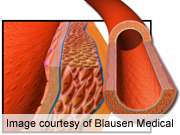USPSTF: evidence lacking for ankle brachial index screening

(HealthDay)—The U.S. Preventive Services Task Force (USPSTF) has found that there is currently insufficient evidence to weigh the benefits and harms of use of the ankle-brachial index (ABI) for screening for peripheral artery disease and for predicting cardiovascular disease risk, according to an evidence review and recommendation statement published in the Sept. 3 issue of the Annals of Internal Medicine.
Jennifer S. Lin, M.D., and colleagues from Kaiser Permanente Northwest in Portland, Ore., reviewed the evidence on the ability of ABI to predict cardiovascular disease morbidity and mortality, independent of the Framingham Risk Score (FRS). Based on one large meta-analysis involving 43,919 participants, the researchers found that ABI could reclassify 10-year coronary artery disease risk, but did not report measures of appropriate reclassification (net reclassification improvement [NRI]). In four heterogeneous risk prediction studies, the magnitude of the NRI was likely small for predicting coronary artery disease or cardiovascular disease events when ABI was added to FRS.
Based of these findings, Virginia A. Moyer, M.D., M.P.H., and colleagues from the USPSTF, updated the 2005 recommendation on screening for peripheral artery disease. The researchers concluded that the current evidence is insufficient to assess the balance of benefits and harms associated with ABI screening for peripheral artery disease and cardiovascular risk assessment in adults (I Statement).
"Even though it is not clear if the ABI helps health care professionals make treatment decisions, there are many things clinicians can do to help their patients reduce their chance of heart attacks and strokes," USPSTF co-vice chair Albert Siu, M.D., M.S.P.H., said in a statement. "The USPSTF recommends screening for and managing high blood pressure, high blood cholesterol, and diabetes and screening for tobacco use and providing cessation support."
More information:
Full Text - Evidence Review
Full Text - Recommendation Statement
Editorial
Copyright © 2013 HealthDay. All rights reserved.




















